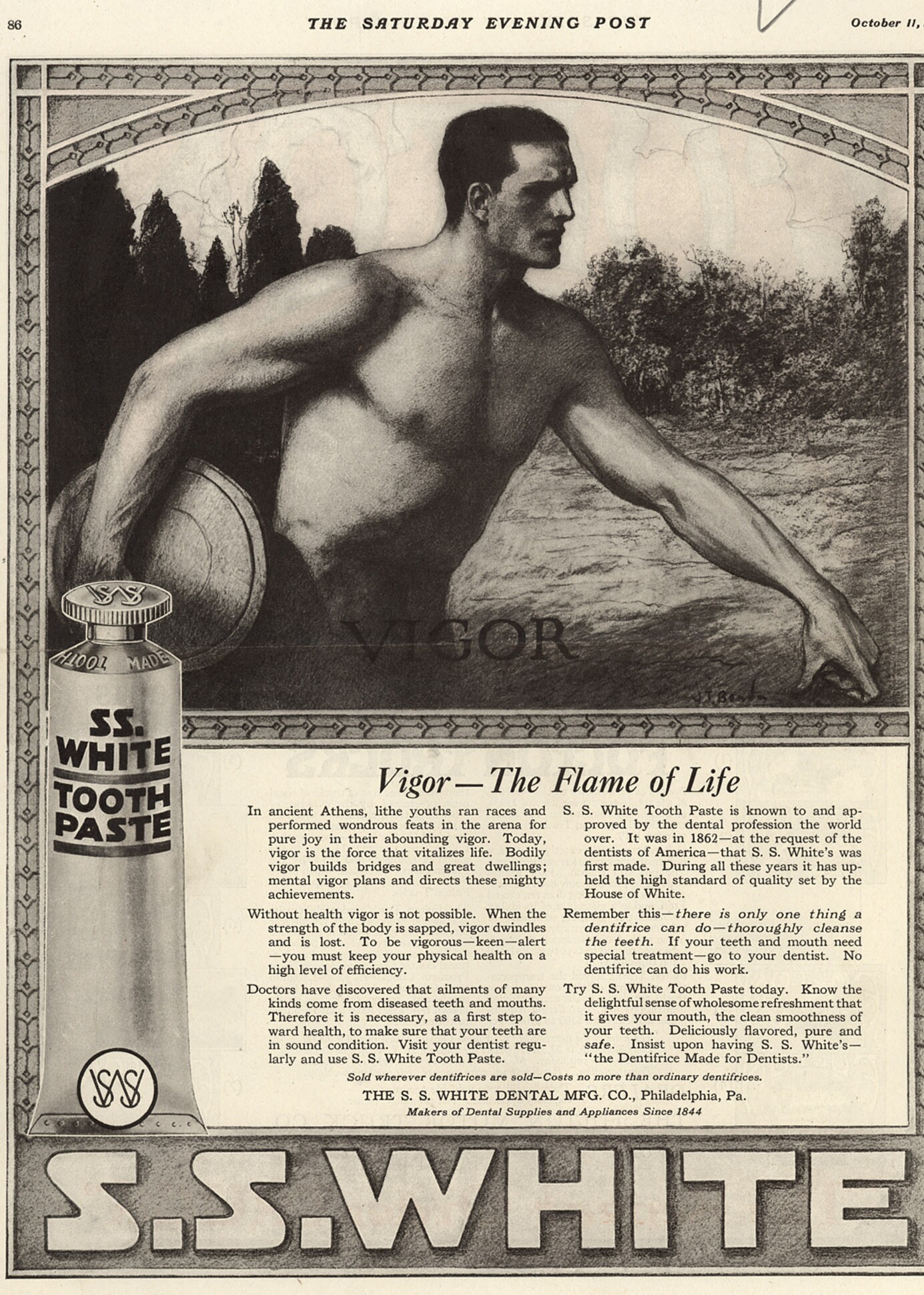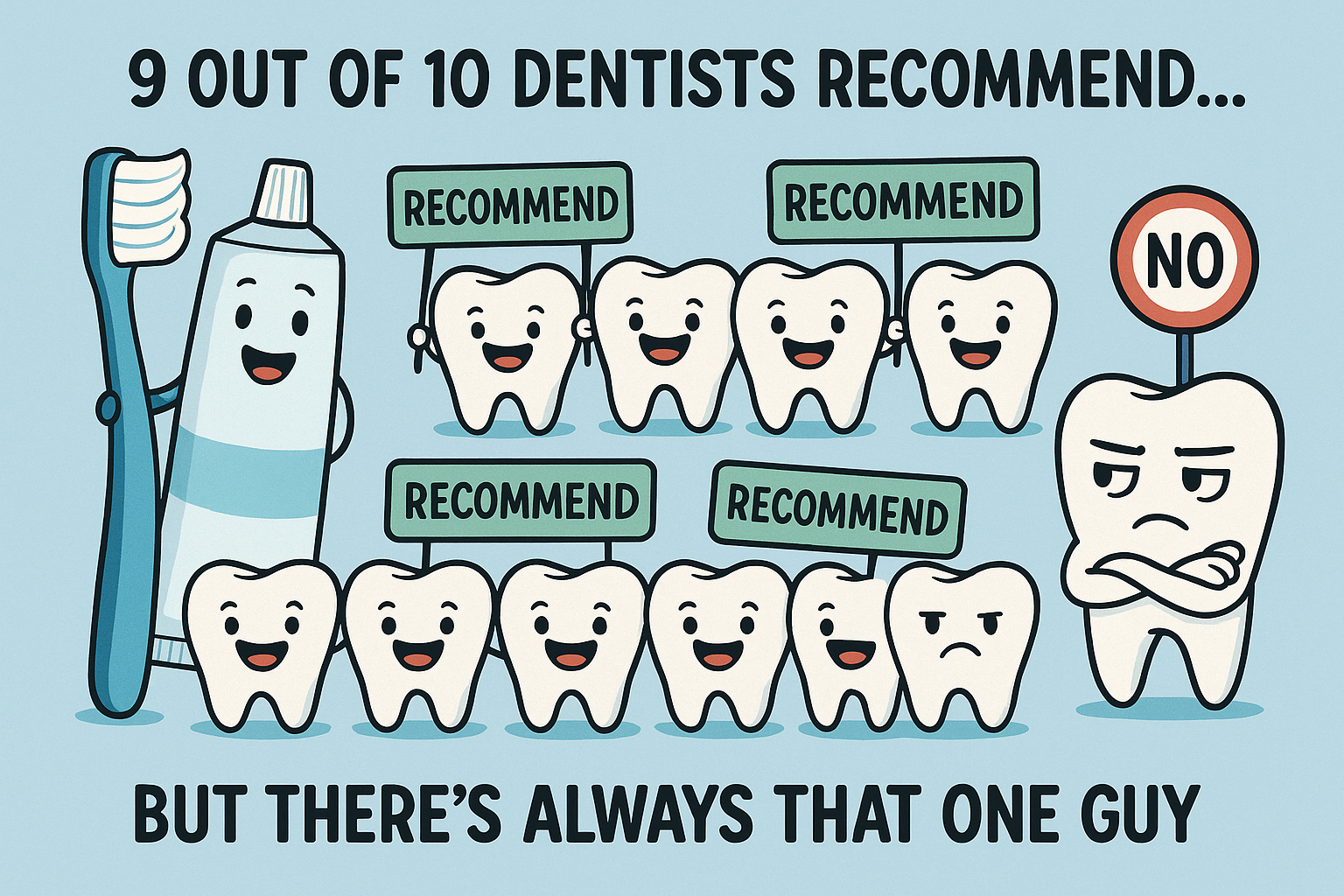
Introduction
Advertising has always been more than a commercial transaction; it’s a cultural language that shapes how we understand success, beauty, and identity. From early print campaigns to today’s digital media, advertising has influenced consumer values and mirrored evolving social norms. Its power lies not just in selling a product, but in selling an idea about the kind of person we should aspire to be. The goal of advertising isn’t just to sell products, it’s to connect them to broader societal dreams and desires. As Garth Sundem points out, advertisements thrive on the idea that if you buy product X, you’ll achieve outcome Y, a better emotion, relationship, status, or experience. This 1920s S. S. White Toothpaste ad masterfully transforms something ordinary into a gateway to masculine vitality and professional success.
Vigor, Strength, and Societal Contribution
At first glance, the ad’s image of a muscular, shirtless man beside the bold word “Vigor” instantly signals the Masculine/Feminine Appeal. According to The Visual Communication Guy, this strategy persuades audiences that using the product can enhance traits associated with their gender, such as being more assertive, more attractive, or more confident. The text reinforces this idea by proclaiming that “Bodily vigor builds bridges and great dwellings; mental vigor plans and directs these mighty achievements.” Here, toothpaste becomes more than hygiene; it becomes a symbol of strength and industriousness.
This message also mirrors a trend from the early 1900s that Sundem described: advertisers framing their products as essential to a “modern” life. S. S. White wasn’t just selling cleaner teeth; it was selling the promise of capability, ambition, and success.
At the same time, the ad taps into a Personal (Emotional) Appeal by referencing “ancient Athens,” where “lithe youths ran races and performed wondrous feats.” This language stirs pride and nostalgia, inviting the reader to see themselves as part of that noble tradition of human excellence. It’s a clever way of turning an everyday grooming habit into a connection with classical heroism.

The Authority of Science and Logic
Beyond emotion and imagery, the ad also presents a Rational Appeal; it frames its message as logical and evidence-based. Health, it argues, is the root of vigor, and healthy teeth are essential for maintaining that strength. Therefore, using S. S. White Toothpaste becomes a reasonable and necessary act.
The ad’s credibility is strengthened through the Endorsement Appeal, assuring readers that the toothpaste is “known to and approved by the dental profession the world over” and was created “at the request of the dentists of America.” This appeal to professional expertise builds trust and authority, aligning with Dennis A. Olsen’s observation that industrial society increasingly looked to professionals and brands for guidance, rather than traditional leaders like family elders or clergy.
Interestingly, the ad even adds a touch of humility, acknowledging that toothpaste alone can only “thoroughly cleanse the teeth,” and that more serious issues require a dentist. This nuance underscores the product’s authenticity and reinforces the dentist as a modern authority figure.

Social Messages and the Target Audience
The message and imagery make the target audience unmistakably clear: the ambitious, hard-working man. The ad ties masculinity to productivity and accomplishment, suggesting that vigor fuels both personal and professional triumphs, “building bridges” in both a literal and metaphorical sense.
As William M. O’Barr notes, early advertising often featured authoritative male figures that reinforced traditional gender roles. Olsen takes this further, arguing that advertisements mirror the “patterns of behavior and cultural standards” of their time. In this case, the link between health, masculinity, and success reflects the cultural expectation of men as providers and builders, a legacy of early 20th-century industrialism.

A Modern Reflection: Shifting Ideals of Cleanliness and Confidence
A modern toothpaste ad, such as Colgate’s “Smile Confidently” campaign, presents a very different message than the 1920s S. S. White promotion. Where S. S. White centered on physical vigor and masculine productivity, Colgate emphasizes emotional wellness and self-confidence. The imagery features diverse, smiling individuals and focuses on words like “fresh,” “bright,” and “confident.” This framing emphasizes inclusivity and personal care over conquest or professional strength. It shows how advertising has shifted from external displays of power to internal expressions of comfort and authenticity.
The appeal to authority remains, albeit in a more subtle form. Instead of grand claims from dentists, modern ads rely on trust through repetition, “recommended by professionals”, and sleek, scientific visuals that suggest technological innovation. This subtle evolution reflects a society more attuned to emotional identification and scientific credibility than to dominance or physical prowess.
Final Thoughts
Looking across time, the changes between the early S. S. White ad and modern advertisements reveal how cultural definitions of “goodness” and success have evolved. Masculine vigor and professional achievement have given way to messages about individual well-being, personal confidence, and inclusivity. These shifts mirror broader societal transitions, from industrial ambition to consumer self-expression, and reflect how the advertising industry continually adapts its appeals to match the cultural moment.
